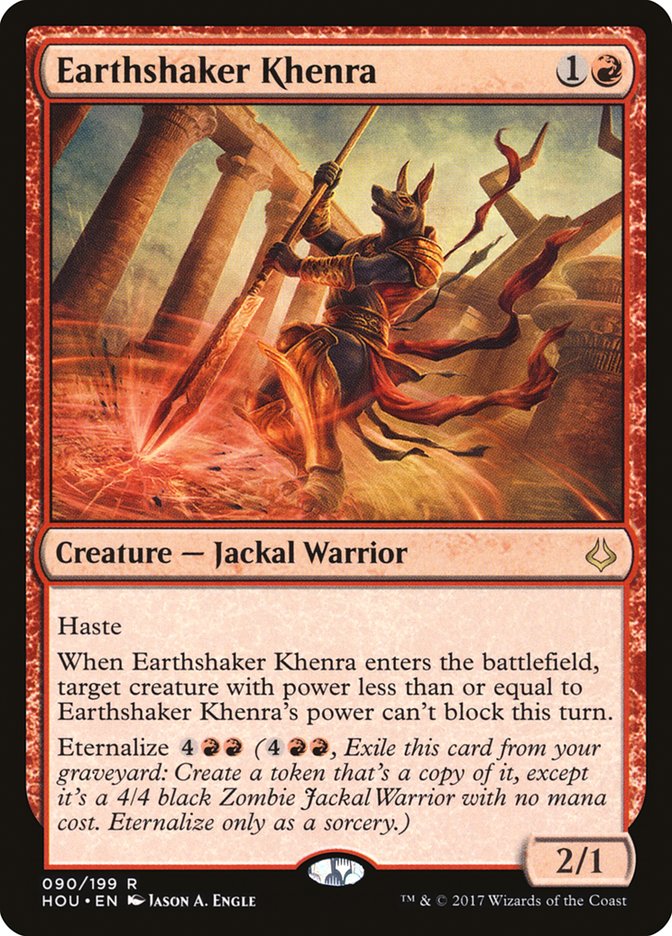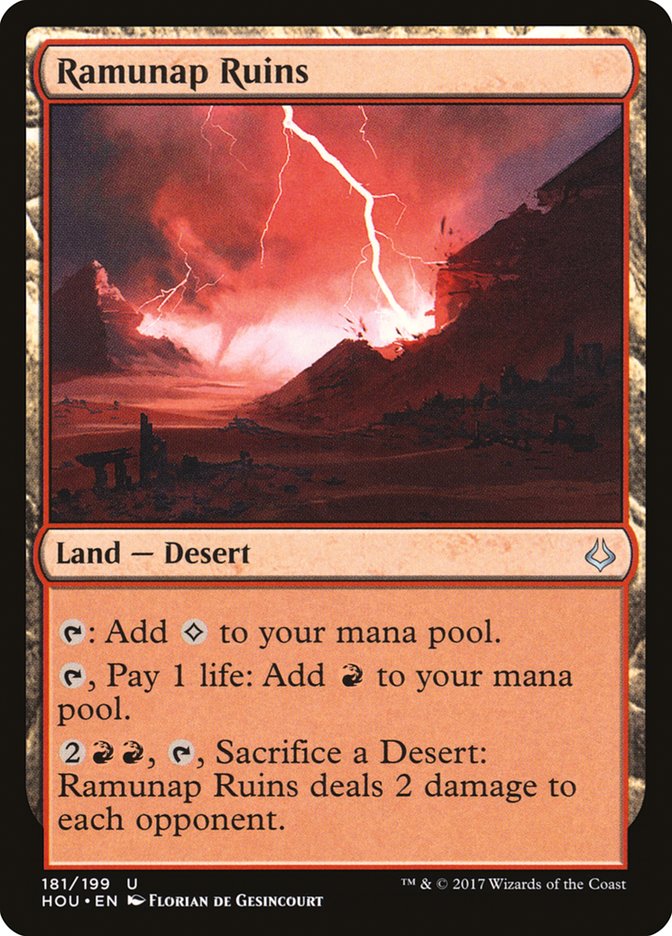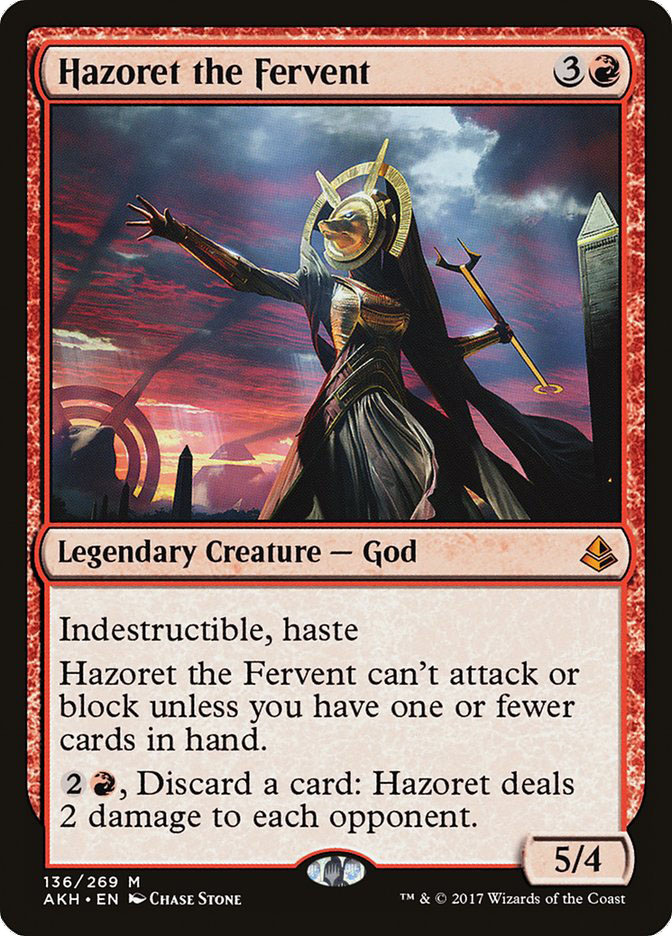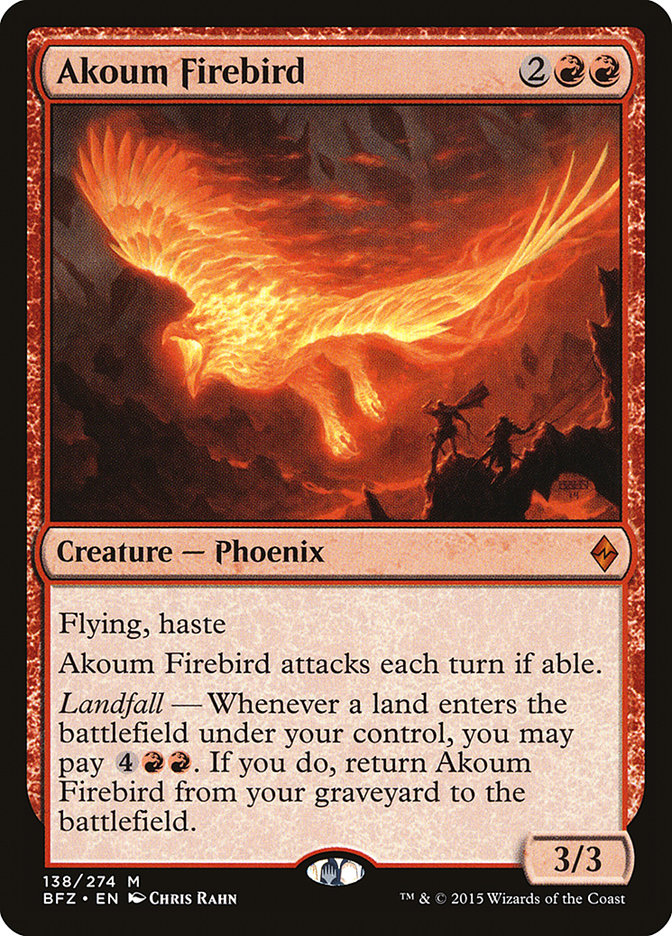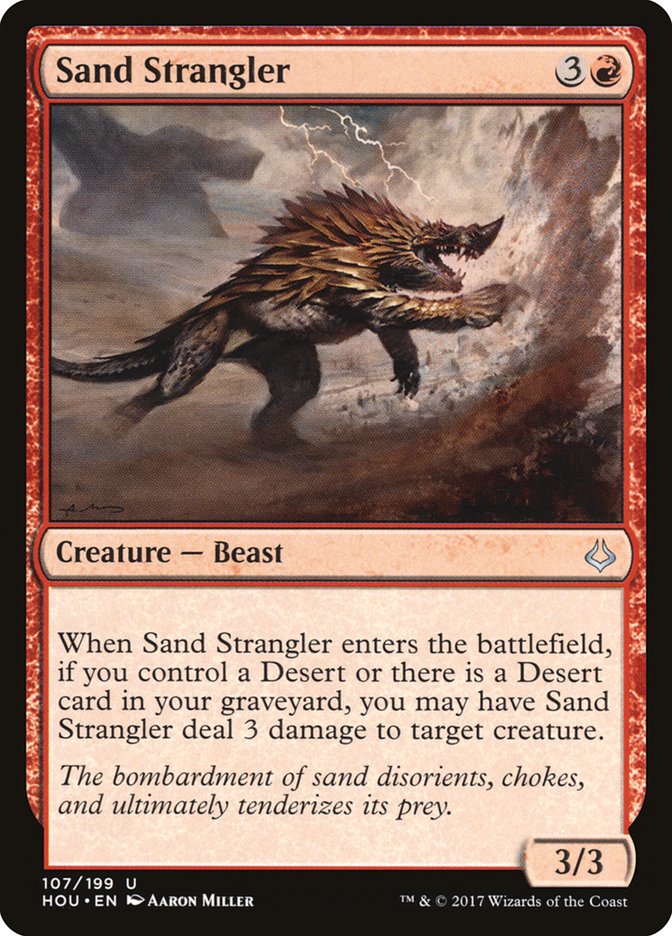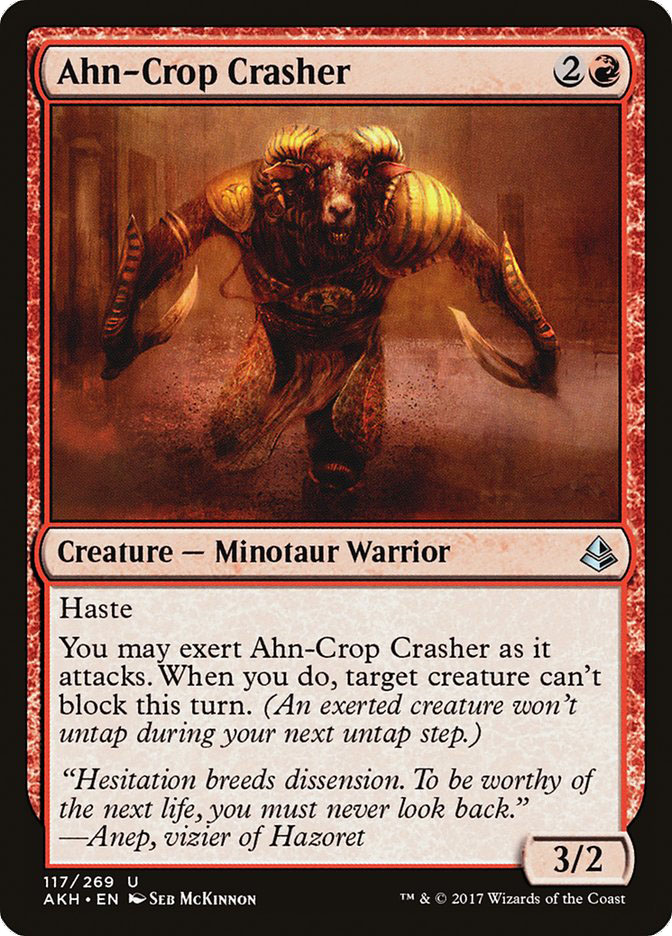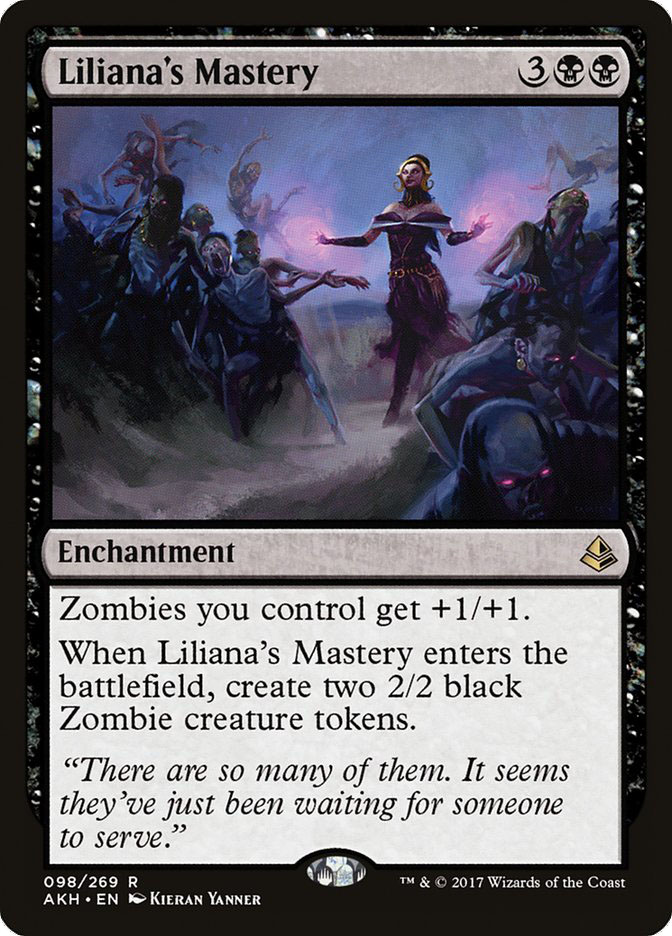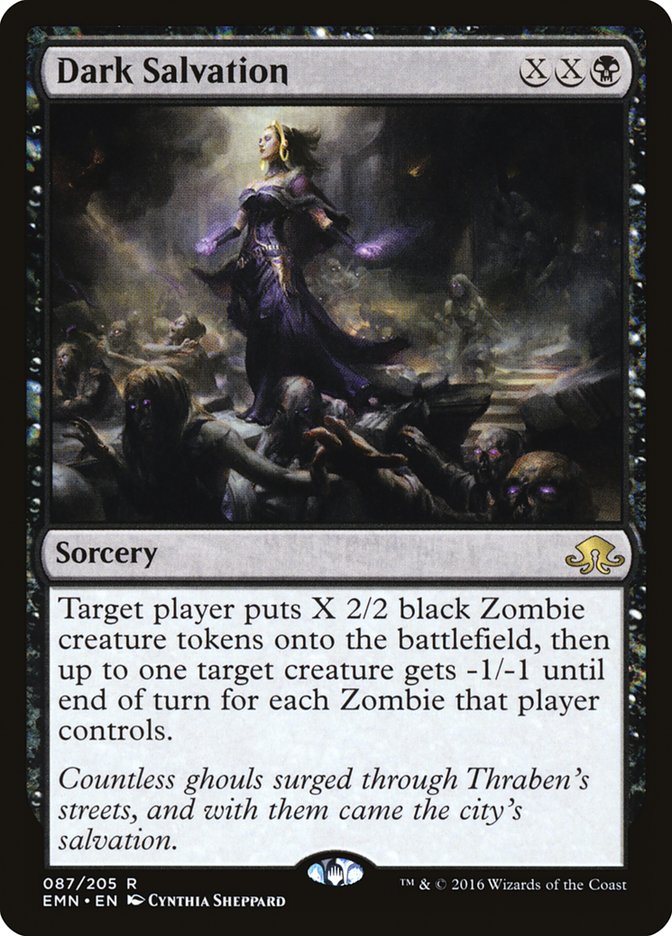Last weekend was Pro Tour Hour of Devastation, and everyone was excited to see what the greatest minds in the game had come up with for this relatively unexplored Standard format. Those in North America had to even stay up past their normal bedtimes to ensure a first glance into what the pros had brought to the table. Excitement levels were at an all-time high, as this was being dubbed a format that felt exploitable. The already overused word “broken” was being thrown around more loosely than ever before. People were ready to be entertained, but as we all know by now, that wasn’t necessarily the case for the late parts of the weekend…
Around 25% of the field showed up with an old deck sporting a new name. Ramunap Red, as they called it, would not only be the most-played deck, but also the best performing archetype. Even as the dust settles we are still unsure if this will be a flash in the pan, or a deck for the ages. Regardless, it’s something you’ll need to understand moving forward, as Ramunap Red isn’t going to disappear overnight. With Grand Prix Minneapolis and Grand Prix Denver on the horizon, it’s most prudent to fully grasp how this deck functions, and that will be the focal point of today’s study.
Part One: The Name
This deck was given the name “Ramunap Red” from Wizards of the Coast as a way to promote the card Ramunap Ruins from their newest expansion Hour of Devastation. This marketing tool can be deceptive at times, as this blanket name encoumpases many mono-red decks that support this card. This makes it ever so important to understand the differences each individual list of Ramunap Red can have. For the time being, there will not be a stock version of this deck, even though history does show that many tend to replicate the winning decklist over any other version of a deck.
Creatures (26)
- 4 Falkenrath Gorger
- 4 Village Messenger
- 4 Bomat Courier
- 3 Kari Zev, Skyship Raider
- 3 Hazoret the Fervent
- 4 Ahn-Crop Crasher
- 4 Earthshaker Khenra
Planeswalkers (2)
Lands (10)
Spells (22)

Paulo Vitor Damo Da Rosa is a twelve-time Pro Tour Top 8 competitor, as well as a member of the Magic Hall of Fame. His win in Kyoto with Ramunap Red would usually hold stock with many of those trying to replicate his results. There is, however, one hiccup in using past trends to identify which variant of Ramunap Red the masses will latch onto.
Part Two: The List
As innocuous as it may seem, one man’s use of 140 characters may end up having the biggest impact on the metagame.
Has anyone noticed that if someone casts Hazoret they win immediately? Took me 5 games to crack that Da Vinci Code and put 4 in my deck
— Owen Turtenwald (@OwenTweetenwald) July 30, 2017
Owen Turtenwald is a two-time Player of the Year from the great state of Wisconsin. When his ill-advised marketing decision to turn his family run cattle farm into a peach garden yielded little-to-no results, he ventured west for a brighter farming future in Las Vegas.
Not a red card. Thus, unplayable.
Often considered Sherlock’s equal, Owen Turtenwald decided to take up competitive Magic after his farming debacle, and joined forces with Reid Duke, Eugene Jensen, and the rest of Team #Sponsored. His goal when joining this team was to gain even more prowess in the Magic universe, as well as help carry the largest collection of Magic has-beens the game has ever known to a Worlds qualification. Sadly, though, their aspirations fell short, and they found themselves finishing in eighth place in the first-ever Pro Tour Team Series.
This didn’t discourage Owen Turtenwald, though. Still considered the best player in the world by all of his closest friends, he graciously bestowed some of his wisdom upon on us via social media. In the aforementioned tweet, Owen Turtenwald graciously exclaimed that we were all collectively idiots for not playing four copies of Hazoret the Fervent.
This drop of wisdom should impact the decision-making of most competitors looking to play Ramunap Red in the upcoming weeks, especially if those who trust in Owen’s abilities blindly pick up the list he choose to play at Pro Tour Hour of Devastation.
Creatures (27)
- 4 Falkenrath Gorger
- 4 Village Messenger
- 4 Bomat Courier
- 3 Kari Zev, Skyship Raider
- 4 Hazoret the Fervent
- 4 Ahn-Crop Crasher
- 4 Earthshaker Khenra
Lands (23)
Spells (10)

Part Three: The Iterations
It’s fairly easy to predict that four Hazoret the Fervent will become the norm, but outside of that, things become more difficult to predict. Owen’s most likely spot-on in his decision to play four of the fiery God, but what about the rest of his decklist? Akoum Firebird, for example, was played in very few lists at Pro Tour Hour of Devastation due to its inability to accomplish anything in a game of Magic.
One of the most powerful cards visible in that front area of Target where all the Pokemon cards are.
This key blunder of a sideboard slot makes it much more believable that players will most likely take cards they like from a variety of lists and ignore those they don’t like or understand, much as one selects food from a buffet, or facts from an argument.
As a renowned leading expert on this format, I believe this to be a common list of Ramunap Red you may see opponents wielding in future weeks:
Creatures (27)
- 4 Falkenrath Gorger
- 4 Village Messenger
- 4 Bomat Courier
- 3 Kari Zev, Skyship Raider
- 4 Hazoret the Fervent
- 4 Ahn-Crop Crasher
- 4 Earthshaker Khenra
Lands (23)
Spells (10)

This list is a very logical jump into predicting how the general population will move forward from intaking information from the Pro Tour. There’s a very high likelihood that most will begin playing four copies of Hazoret the Fervent and move Chandra, Torch of Defiance to the sideboard. Even if playing one copy of this powerful planeswalker is correct, many will ignore doing so thanks to how aesthetically displeasing this may look. With this in mind, many will move towards Owen Turtenwald’s maindeck and begin exploring for changes to the sideboard.
Whether it was correct or not, Paulo’s sideboard will most likely have the most influence on players wanting to play Ramunap Red moving forward. That said, they will need to make adjustments for the newly repositioned planeswalker, and possibly a copy or two of Abrade. Sand Strangler is the biggest outlier, since it wasn’t seen in many sideboards, but Team Former Team (The Conglomerate) did do some impressive things with that card. That’s why it’s understandable to predict many will continue playing this card.
Part Four: Understanding Ramunap Red
Many Pro Tour viewers were not expecting such a dominant performance from such a linear monocolor strategy. Given this shocking (Shock-ing?) turn of events, there won’t be a large following that truly understand the deck and its capabilities. For those who believe they are in this camp, this next chapter is for you.
Ramunap Red is a linear “Sligh” deck Game 1. Its goal is simple: get on the battlefield with quick creatures that deal early damage and follow that up with the reach Hazoret the Fervent provides to finish the game. This task is easily accomplished, given how much early damage cards like Earthshaker Khenra and Ahn-Crop Crasher can provide even in the face of opposition. Even when an early rush is negated, the power of Hazoret the Fervent has the potential to create damage pockets that can diminish an opponent’s life from even the high teens.
After sideboarding, the deck is designed to slow down, even sometimes to the point where it would be considered a midrange deck. Cards like Glorybringer, Sand Strangler, Aethersphere Harvester, and Chandra, Torch of Defiance facilitate this, as these cards are at a high enough density to allow one to replace a large chunk of the maindeck.
This is where the deck gains much of its edge against the field. By now players are familiar with transformative sideboards, but that doesn’t always diminish their effectiveness. Ramunap Red starts such an aggressive package in their maindeck that it’s difficult to ignore that in post-sideboard games. Even when the opposition knows a transformation is coming, they still need to somewhat thwart early aggression. They lower their curve in an attempt to beat the preemptive assault, while Ramunap Red ramps up their curve for more powerful finishers. Knowing is half the battle, but that doesn’t mean it wins the war.
Part Five: Understanding the Matchups
Along the same lines, it’s vital that you know how to interact with Ramunap Red. In this section, we will go through each popular matchup Ramunap Red will face and discuss what should be done on each side of the coin.
Creatures (23)
- 3 Kalitas, Traitor of Ghet
- 4 Relentless Dead
- 4 Diregraf Colossus
- 4 Cryptbreaker
- 4 Lord of the Accursed
- 4 Dread Wanderer
Lands (24)
Spells (13)

Mono-Black Zombies was the second-most-played deck at the Pro Tour, and for good reason. It’s one of the only decks that the collective found to have a good matchup against Ramunap Red. Being inherently good against Ramunap Red is very important, and that’s exactly what Mono-Black Zombies has. The deck plays cheap removal in the form of Fatal Push and the cleanest answer to Hazoret the Fervent in the form of Grasp of Darkness.
Past the Mono-Black Zombies removal suite is a very good curve of creatures that will force Ramunap Red to interact even as early as turn 1. The advantage this red deck has is getting to the battlefield first, but that is taken away when combating Mono-Black Zombies. That said, the creatures in Mono-Black Zombies are weaker on base stats, which does pose a serious problem for the strategy in the early turns. These creatures aren’t why Mono-Black Zombies has a favorable matchup, however. The real heroes of the matchup come in the form of Liliana’s Mastery and Dark Salvation.
These two “five-drops” turn the matchup toward Mono-Black Zombies and are why Ramunap Red has to transition their gameplan post sideboard. These two cards are capable of clogging up the board for Ramunap Red so badly that they no longer have combat as an avenue for damage. Without this vital path to victory, Ramunap Red has to transition into a burn deck, which it isn’t well-equipped to do.
Ramunap Red’s best card in the matchup is Chandra, Torch of Defiance, as it’s a steady stream of card advantage. Rarely is this planeswalker’s life threatened, given how easy it is for Ramunap Red to kill the early creatures out of Mono-Black Zombies. Even so, cards like Liliana’s Mastery will eventually take hold and force Ramunap Red to either close out the game quickly or succumb to a horde of Zombie tokens. This is why Ramunap Red cannot simply take a completely controlling role in the matchup, as their removal will eventually get outpaced.
This is why Mono-Black Zombies should continue to incorporate some numbers of Never // Return into their strategy against Ramunap Red. Many of the red deck’s early creatures will be taken out in favor of more powerful effects. This swap should be anticipated by Mono-Black Zombies so they don’t get caught off-guard when their Fatal Pushes are left stranded in their hand.
Creatures (20)
- 3 Archangel Avacyn
- 4 Thraben Inspector
- 2 Pia Nalaar
- 4 Scrapheap Scrounger
- 4 Toolcraft Exemplar
- 3 Walking Ballista
Planeswalkers (2)
Lands (24)
Spells (14)

Mardu Vehicles has recently undergone a significant facelift relative to what it previously looked like. Cards like Heart of Kiran and Unlicensed Disintegration have become weaker, and it shows as many have taken out the fourth copy of both of these, previously considered sacred cows. Now the deck focuses more on cards like Aethersphere Harvester and Walking Ballista to combat both Mono-Black Zombies and Ramunap Red. Some players like Raphael Levy have even went back to playing a fourth color to help fight these matchups by adding an innocuous Bird into the mix.
Creatures (19)
- 4 Thraben Inspector
- 1 Filigree Familiar
- 3 Glint-Nest Crane
- 3 Scrapheap Scrounger
- 4 Toolcraft Exemplar
- 4 Walking Ballista
Planeswalkers (4)
Lands (23)
Spells (14)

Glint-Nest Crane is an interesting addition, as it not only crews Aethersphere Harvester but finds it as well. This is important, as this Vehicle is very strong against the two most popular decks right now. The downside to this build, however, is its sacrifice of power against many of the decks that aren’t good against Ramunap Red, like G/R Ramp and U/R Control. This build is even weaker than older variations on the deck when it comes to matchups like B/G Delirium and B/G Energy. The upside may be worth it, but I believe few will make the change.
That said, Ramunap Red does have a good matchup here. Cards like Authority of the Consuls will help Mardu Vehicles in the matchup as long as they are drawn early, but for the most part Ramanap Red will have the advantage over the long run. Early creatures backed up by Hazoret the Fervent and Abrade is just a combination that Mardu Vehicles has problems with, especially when their initial Knight Ally from Gideon, Ally of Zendikar finds itself unable to protect the important planeswalker.
Creatures (20)
- 2 Kalitas, Traitor of Ghet
- 3 Tireless Tracker
- 4 Grim Flayer
- 2 Verdurous Gearhulk
- 4 Winding Constrictor
- 1 Rishkar, Peema Renegade
- 4 Walking Ballista
Planeswalkers (5)
Lands (18)
Spells (17)

Any deck with Grasp of Darkness will have a better chance to defeat Ramunap Red than those who don’t, which points towards respecting this deck to be highly played in the upcoming weeks. Its strength comes from the synergies its cards create on the battlefield, thus making traction the main focal point for the matchup. The deck will try to get multiple permanents deployed, while Ramunap Red will try to keep them off the battlefield. Many of the B/G deck’s threats are must-kill in the early stages of the game but can be ignored once tempo becomes the best outlet for success. This is why you will see the importance of killing a Winding Constrictor go down as the game progresses. Not only will Ramunap Red have a lower likelihood of having the resources to dispatch the Snake, but they will also begin to prioritize dealing damage to the face.
B/G will often not have many cards in the sideboard to bring in, while Ramunap Red will most likely shift the value of its cards depending on the play or draw. Anything that can kill a creature will be brought in and replace cheap creatures that often die to a barrage of effects B/G has access to.
Creatures (25)
- 4 Falkenrath Gorger
- 4 Bomat Courier
- 2 Kari Zev, Skyship Raider
- 3 Hazoret the Fervent
- 4 Ahn-Crop Crasher
- 4 Soul-Scar Mage
- 4 Earthshaker Khenra
Lands (23)
Spells (12)

The Ramunap Red Rirror is more unusual than it is intricate. Previously, red rirrors always revolved around having more resources than your opponent. Everything died to cheap removal, making it important to not run out of resources. This has since changed thanks to Hazoret the Fervent, since the only thing that matters in the Ramunap Rirror is the God. Many even replaced Village Messenger with Soul-Scar Mage in an attempt to combo it with burn spells to take down the God, but that rarely worked in practice.
Given how effective this god is in the mirror, the whole gameplan should revolve around it. A balance of proactive and reactive elements is important to facilitate Hazoret the Fervent. You don’t want your hand to be all removal spells, nor do you want to get stuck on less than four lands. This is why you see extra lands in the sideboard, as well as additional threats to bring in. Finding the correct balance is difficult even for the best in the world, since the rirror can be so volatile at times. It’s important you play games yourself to understand how to value things, because this mono-red rirror isn’t something theory can carry you through.
Part Six: Predicting the Metagame
It’s difficult to know with certainty what will be expected out of the metagame in the following weeks, but one thing to keep in mind is the collective should no longer be underestimated. For years, we’ve seen players slow to change, but recently that hasn’t been the case. With this in mind, it’s in your best interest to predict more anti-red strategies than red strategies. Decks like Mono-Black Zombies or B/G Delirium may very well take over as the most played decks, and those targeting them may become the best-performing strategies. Even so, Ramunap Red should still be a great choice for anyone wanting to get their feet wet in current Standard…as long as they know what they’re getting themselves into and have adequately prepared themselves for the hate players will be packing.


